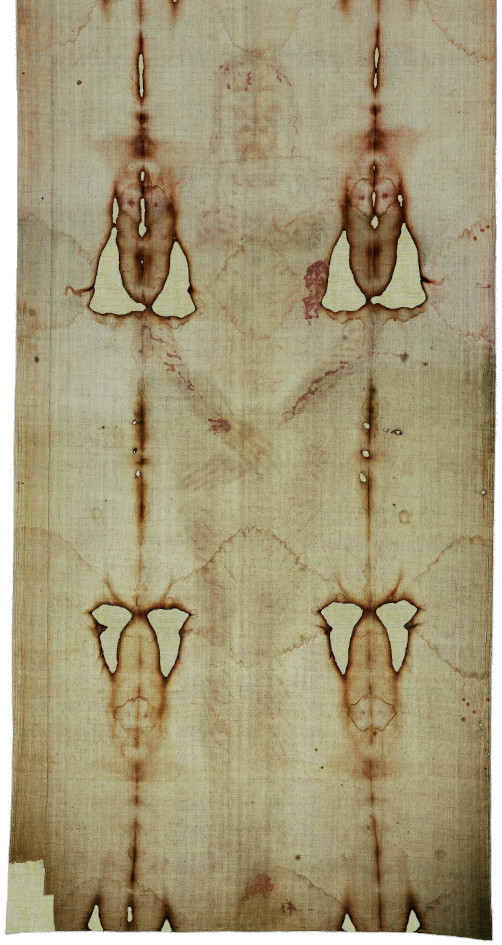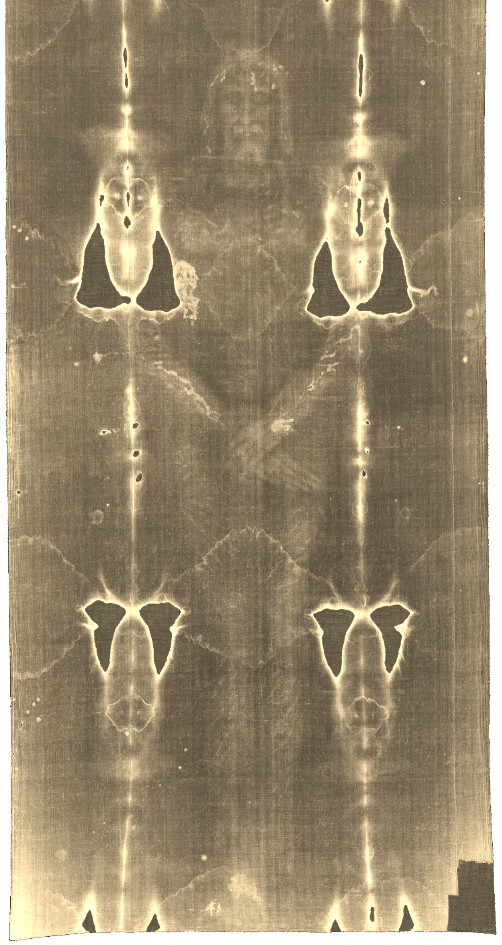Click on the points to get information.

The Shroud
The Holy Shroud (in Greek sindon, sheet) is a linen cloth (441 x 113 cm) on which two dark stripes and numerous triangular holes are visible: these are traces of a fire that took place in 1532 in Chambéry (France). Water halos are also visible. In the centre is a double human figure, front and back. An ancient tradition holds that the Shroud of Turin is the burial cloth of Jesus Christ. The cloth was in the possession of the Savoy family from 1453 until 1983, when Humbert II donated it to the Pope. It has been kept in Turin since 1578.
The photographic negative, thanks to the first photographs taken by Secondo Pia in 1898, revealed the features of the body in greater detail and aroused the interest of science. Since then, numerous doctors have been able to carry out a series of medico- legal investigations.
The chiaroscuro of the image reveals the three-dimensional shape of the body, a unique peculiarity. There are also numerous bloodstains: it was the body of a scourged man, crowned with thorns, crucified with nails and pierced by a lance in the right side. The time of contact between the body and the sheet has been estimated at 36-40 hours. This coincides with the narrative of the Passion of Jesus Christ in the Gospels. The origin of the human imprint, formed by a process of dehydration and oxidation of the surface fibrils of the linen, remains a mystery. Some experiments suggest that the image could be explained as the effect of a powerful light emitted by the body.
The first certain historical records of the existence of the Shroud date back to the mid-14th century, but there are consistent indications of its existence in earlier centuries. Moreover, analysis of many artistic depictions of the Face of Jesus shows striking similarities to that of the Shroud. That is why some experts claim that it was the prototype of the representations of the Face of the Lord.
A group of scientists, the Shroud of Turin Research Project (STURP), examined the Shroud in 1978 with the most modern scientific equipment of the time. They published the results in more than 20 articles in scientific journals in 1981, concluding that the Shroud enveloped a real, scourged and crucified human body. The image is not the product of an artist.
In 1988, the Shroud was dated by the carbon-14 method, which dated it to between 1260 and 1390 A.D. However, this result is now considered unreliable for a cloth that has gone through vicissitudes such as those of the Shroud. On the other hand, many other scientific studies confirm its authenticity.
Professoressa Emanuela Marinelli
Professor Padre
Rafael Pascual
The photographic negative
The image of the Shroud we observe here is in positive, as it appears to the naked eye on the cloth. However, it is important to consider that the imprint of the Man of the Shroud was formed like the reflected image in a mirror. One clear example is the wound on the side. On the cloth, it appears on the left side, but this is due to the fact that the Body left a mirrored imprint.
To better understand the actual position of the wounds and other anatomical features, a simple horizontal flipping of the image is often used. This process allows the Man of the Shroud to be visualized as he would have appeared in reality, with the wound actually located on the right side.
Similarly, the printed photographic negative inverts the light and dark values, allowing the features of the Man of the Shroud to be correctly visualized.
Click on the image to view the flipping and the inversion of the light and dark values.


The Sudarium
In the Cathedral of Oviedo, where the Primitive Way of St. James begins, a bloody linen cloth measuring 84 x 53 cm, known as the Sudarium or Pañolón, has been preserved since the 9th century. This cloth is mentioned in the 20th chapter of the Gospel of John. Forensic studies have shown that the bloodstains match those on the face and neck of the Man of the Shroud. EDICES (Research Team of the Spanish Centre of Sindonology) scholars have deduced that the Shroud was most likely wrapped around the head and face of Jesus after his death, while he was still nailed to the cross, at the time of his deposition and during transport to the tomb, where the cloth would be removed to wrap the corpse in the Shroud. Its main function was to prevent the dispersion of blood fluids mixed with lung fluid during these stages of the deposition. Removed from the head, it was buried with the body, as prescribed by Jewish burial customs.
The Shroud and the Sudarium have the same composition and the same manufacturing technique, with the "Z" twisting of the threads, although the Shroud is woven in herringbone, while the Sudarium is woven orthogonally. The origin seems to be the same: the Near East. The pollen helps to reconstruct the geographical route of both relics, which would have remained in the Jerusalem area and then reached Europe by two different routes: via Turkey for the Shroud, via North Africa for the Sudarium.
- Radiocarbon Dating of the Turin Shroud: New Evidence from Raw Data
- Statistical and Proactive Analysis of an Inter-Laboratory Comparison: The Radiocarbon Dating of the Shroud of Turin
- A Comprehensive Examination of the Various Stains and Images on the Shroud of Turin
- shroud.com
- "El Sudario de Oviedo" de Jorge Manuel Rodríguez Almenar
- Home page di Ostensione Diffusa
